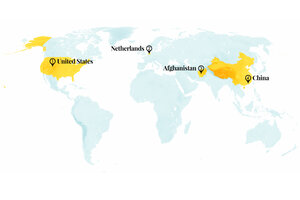Bright spots: Dark sky in China, and TV lessons for Afghan girls

1. United States
Chemists at Colorado State University designed a process for making a sustainable synthetic plastic. The discovery holds promise for a circular economy based on polyhydroxyalkanoates, or PHAs.
Some living microorganisms make PHAs via bacterial fermentation, but synthetic PHAs are expensive to produce and are more brittle and less durable than petrochemical-based plastic.
The research team set out to improve the heat resistance of PHAs and their ability to be molded from liquid into shapes. The new method also improved recyclability and toughness. The team says its PHAs outperformed both high-density polyethylene and isotactic propylene, which is used to make automotive parts and synthetic fibers. Future applications include everything from packaging to toys.
Sources: Colorado State University, Science, BioResources
Why We Wrote This
In our progress roundup, new windows on the world are opened. The BBC is offering educational programs for children in Afghanistan who aren’t allowed at school. And in China, a small community is the country’s first certified fighter of light pollution.
2. Netherlands
Amsterdam created more space for bicycles – underwater. Two new underwater garages adjacent to the city’s Central Station house 11,000 spaces for bikes and none for cars. More than 200,000 people arrive at the transportation hub every day, about half of them on bicycles. Because of inadequate legal parking, many riders previously risked ticketing or impoundment to lock their bikes, or they simply left their bikes unlocked. Now they can park for free at the new facilities for up to 24 hours.
Art lines walkways and walls in the light-filled facilities, and curved surfaces are a tribute to the surrounding water. The two garages cost about €85 million ($94 million).
Bicycles account for 36% of all traffic in Amsterdam. The larger redevelopment project of the city’s main railway station aims to welcome more pedestrians and cyclists, and further reduce car use.
“It’s a lovely project, because it’s not a cycling project,” said Marco te Brömmelstroet of Amsterdam University. “It makes visible the real (and often invisible) success factor in Dutch mobility and spatial policy: the bike-train combination.”
Sources: The Guardian, The Verge, Dezeen
3. Afghanistan
Afghan children banned from school can access some education via new weekly television and radio programs. The BBC-produced Dars – which means “lesson” in Dari and Pashto – will air four times a day on the newly launched BBC News Afghanistan channel, as well as on BBC News Pashto and Dari Facebook channels, BBC Persian TV, and on BBC radio throughout Afghanistan. The half-hour episodes are hosted by female Afghan journalists who were evacuated from Kabul during the 2021 Taliban takeover.
The show targets children ages 11 to 16. The Taliban declared shortly after it resumed power that girls would no longer be able to attend school beyond the sixth grade, and in December 2022, it suspended university education for women. In the previous two decades, the country had made strides in educating its girls: According to UNESCO, the female literacy rate had nearly doubled, from 17% to 30%; the number of girls in primary school went from nearly none to 2.5 million; and the number of girls in higher education was more than 100,000, up from 5,000. Today, about 2.5 million girls and young women – 80% – are out of school.
Sources: BBC, UNESCO
4. China
The first place in China to earn International Dark-Sky Association (IDA) recognition is the Xichong community, 60 kilometers (37 miles) from the urban center of Shenzhen. A popular area for surfers and beachgoers, Xichong adopted modifications to outdoor lighting and a commitment to dark sky awareness to achieve IDA “Community” status, one of five levels of certification for fighting light pollution.
With increasing urbanization, excess lighting has negative effects on humans, wildlife, and our ability to observe the night sky. Around 200 places worldwide have IDA status, from vast, remote sanctuaries to communities less than a square mile in size.
The Xichong community includes about 2,500 people from eight villages and the only observatory in southern China. Lin Mei, a research associate at the observatory, says the IDA status “has effectively reduced the night sky background brightness for Shenzhen Observatory, facilitated astronomical observation and research, and created an excellent stargazing destination for all citizens.”
Sources: International Dark-Sky Association, Shenzhen Daily
World
Venture investment in climate technology is 40 times what it was 10 years ago. According to market researcher Holon IQ, venture funding for climate tech startups was up 89% in 2022 over the previous year, pouring $70.1 billion into companies focused on addressing global warming.
Experts attribute the financial push to trends in corporate responsibility and pledges by companies and governments around the world to reduce greenhouse gas emissions. The United States invests more than any other region, followed by China, then Europe.
“Venture capital investors are not asking for the highest [return on investment] anymore. They’re asking for a mix of profitability, but also positive impact,” said Raphaele Leyendecker, managing director at Techstars Sustainability Paris Accelerator. “The investment is being redirected to game-changer technologies that are helping the planet actually live longer.”
Sources: Holon IQ, Bloomberg

